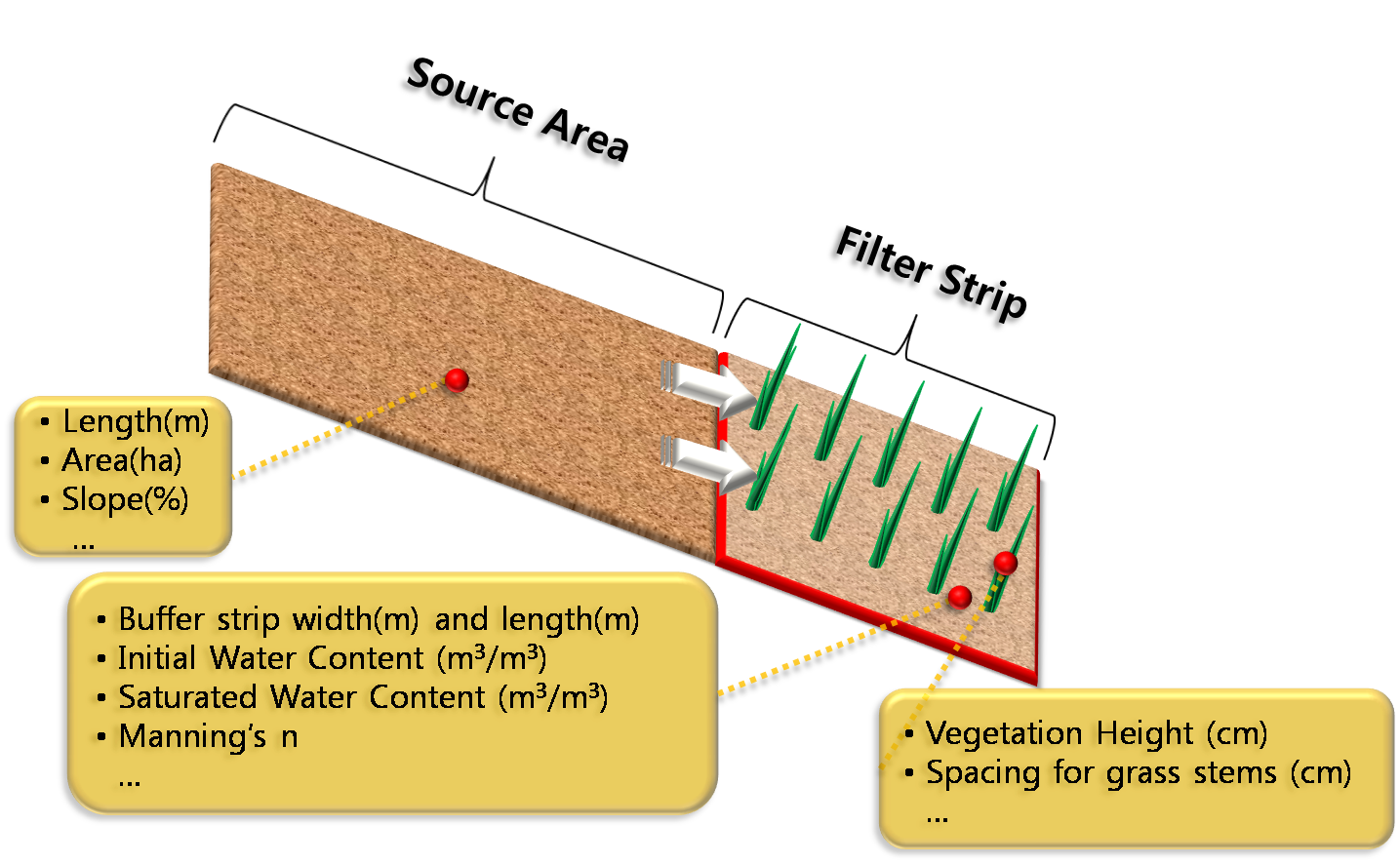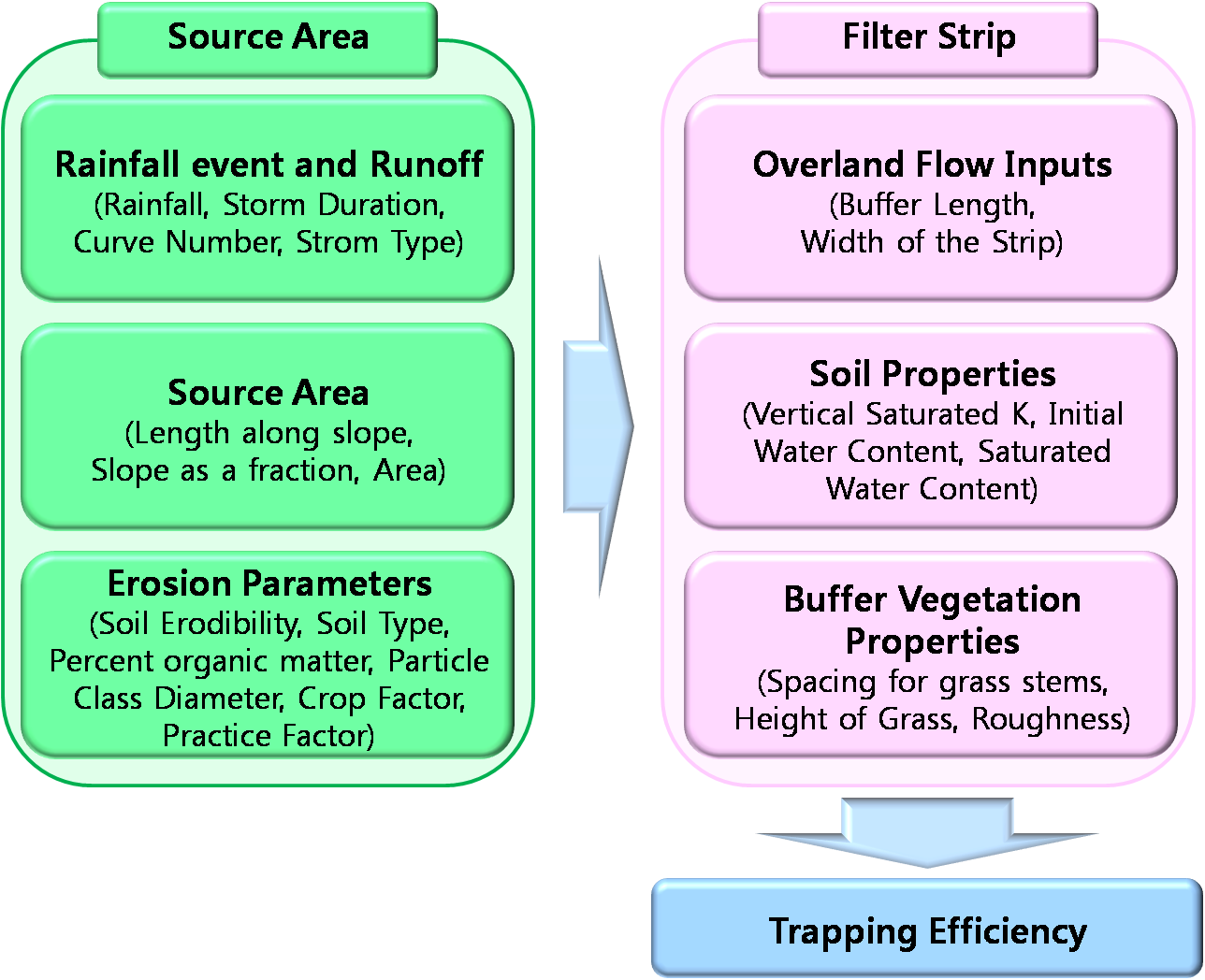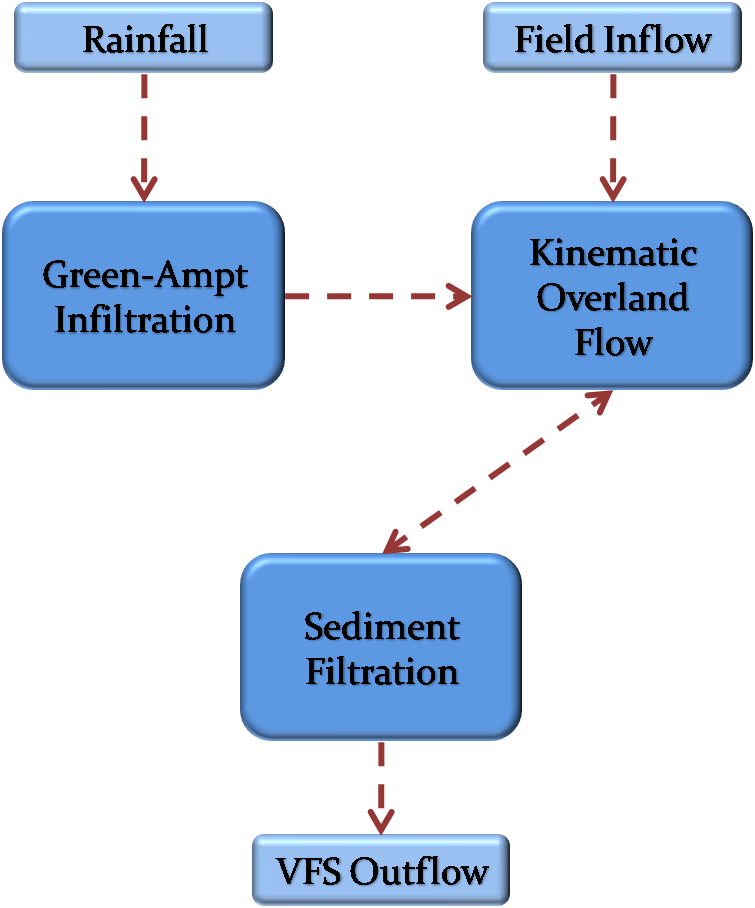One of the Best Management Practices (BMP) promoted by state and federal agencies to protect water resources from non-point source pollution is the installment of VFS. The VFS are land areas of planted vegetation, usually grasses, installed at the edge of agricultural areas or animal production facilities to filter nutrient, sediment, organics, pathogens, and pesticides from agricultural runoff before it reaches a water system such as streams or rivers. The VFS is effective in reducing sediment (*Neibling and Alberts, 1979) and other pollutants (*Lee et al., 1999; *Mersie et al., 1999). These studies reported that the VFS can reduce pollutant loads by reducing velocity of surface flow from agricultural areas and causing infiltration. The performance of VFS is affected by many parameters, such as slope, volume of runoff, soil type, and vegetation characteristics. The VFS is a dynamic system with many parameters; also these time-variant factors can affect the VFS performance. Therefore, site specific management methods need to be evaluated and developed for successful functioning of the VFS (*Otto et al., 2008). These important and various factors affecting VFS performance have to be considered by the Vegetated Filter Strip model (VFSMOD), developed by Rafael Muñoz-Carpena (1999*). The VFSMOD system is a desktop based model, and it requires many and various input data as it considers various conditions of field and VFS. The field-scale, mechanistic, storm-based VFSMOD is designed to simulate the hydrograph by rainfall and sediment inflow from an adjacent upper field. The model calculates the outflow, infiltration, and sediment reduction through VFS from adjacent upper field (*Muñoz-Carpena, 2005). So, the model can be used to predict sediment transport through VFS, simulates outflow and sediment reduction in VFS based overland flow hydraulics and infiltration into the soil layer (*Amanda et al., 2005) (Figure 1).

Figure 1. Source area and Filter strip in VFSMOD-w
The VFSMOD was successfully tested with natural events with North Carolina Piedmont data (*Muñoz-Carpena, 1999) and Coastal Plain (*Muñoz-Carpena, 1993). Researchers, at the University of Guelph in Canada, tested the model with field experimental data (*Abu-Zreig et al., 2001). They reported good agreement between model simulations (infiltration, outflow, and sediment trapping) and measured values. Recently the model has been used to model the effect of VFS in a small watershed (817 m * 875 m) (*Kizil and Disrud, 2002), also a study to simulate fecal pathogen transport and filtering in VFS (*Zhang et al., 2001). Also the model has been tested against field experimental data, and it showed good agreement (R2=0.9) with a linear relationship between model predictions and observed values (*Gharabaghi et al., 2001).
The VFSMOD requires input data such as ¡®rainfall¡¯, ¡®storm duration¡¯, ¡®curve number¡¯ ,and ¡®storm type¡¯ for ¡®Rainfall event and Runoff¡¯ option, ¡®length along area¡¯, ¡®slope as a fraction¡¯ ,and ¡®area¡¯ for ¡®Source Area¡¯ option, ¡®soil erodibility¡¯, ¡®soil type¡¯, ¡®percent organic matter¡¯, ¡®particle class diameter¡¯, ¡®crop factor¡¯, ¡®practice factor¡¯ for ¡®Erosion Parameter¡¯ option in source area parameter. Also, it requires input data such as ¡®buffer length¡¯, ¡®width of the strip¡¯ for ¡®overland flow inputs¡¯ option, ¡®vertical saturated K¡¯, ¡®initial water content¡¯, ¡®saturated water content¡¯ for ¡®Soil properties¡¯, ¡®spacing for grass stems¡¯, ¡®height of grass¡¯, ¡®roughness¡¯ for ¡®Buffer vegetation properties¡¯ option in filter strip parameter (Figure 2).

Figure 2. Input data of Source Area and Filter Strip Component of the VFSMOD
The VFSMOD model handles time based hyetographs, spatially distributed filter parameters (vegetation roughness or stem spacing, slope of source area and buffer strip, infiltration characteristics of buffer strip soil) and different particle size of sediment from the source area. The sub modules are used such as ¡®Green-Ampt infiltration module¡¯ for calculating the water balance in the soil surface, ¡®kinematic wave overland module¡¯ for calculating flow depth and rates in the infiltrating soil surface, ¡®sediment filtration module¡¯ for simulating transport and deposition of the incoming sediment along the VFS from source area (Figure 3).

Figure 3. Overview of sub-modules in VFSMOD-w
In the process of hydrology, the rainfall excess is calculated from the hyetograph and a modification to the Greem-Ampt infiltration method at every time step is calculated for a given rainfall distribution for each node and time step by the infiltration model. The model can be operated to simulate the various effect of soil type (infiltration), slope of source area, slope of VFS, surface roughness, filter length, storm pattern, vegetation type, and field inflow on VFS performance. Also it describes the flow rate, velocity, and depth throughout the filter for each time step (*Muñoz-Carpena, 2005).
|
1. Abu-Zreig, M., Rudra, R. P., Whiteley, H. R., 2001. Validation of a vegetated filter strip model (VFSMOD). Hydrol. Process. 15(5): 729-742.
2. Amanda, L.F., Dean, E.E., Michael, G.D., 2005. Modeling Water and Sediment Trapping by Vegetated Filter Using VFSMOD: Comparing Methods for Estimating Infiltration Parameters. ASAE Paper No. 052118, 2-4.
3. Gharabaghi, B., Whiteley, H. R., Dickinson, W. T., 2001. Sediment removal efficiency of vegetative filter strips. ASAE Paper No. 012071. St. Joseph, Mich.: ASAE.38-39.
4. Kizil, U., Disrud, L. A., 2002. Vegetative filter strips modeling of a small watershed. ASAE Paper No. 022133. St. Joseph, Mich.: ASAE.
5. Lee, K.H., Isenhart, T.M., Schultz, R.C., Mickelson, S.K., 1999. Nutrient and sediment removal by switchgrass and cool-season grass filter strips in Central Iowa, USA. Agrofor. Syst. (44): 121?132.
6. Mersie, W., Seybold, C.A., McNamee, C.M., Huang, J., 1999. Effectiveness of switchgrass filter strips in removing dissolved atrazine and metolachlor from runoff. J. Environ. Qual. (2): 816?821.
7. Muñoz, R., Miller, C. T., Parsons, J. E., 1993. A quadratic Petrov?Galerkin solution for kinematic wave overland flow. Water Resour. Res. 29(8): 2615?2627.
8. Muñoz, R., Parsons, J. E., Gilliam, J. W., 1999. Modeling hydrology and sediment transport in vegetative filter strips and riparian areas. J. Hydrology 214(1-4): 111?129.
9. Muñoz, R., Parsons, J. E., 2005. VFSMOD, versoin 2.x, User's Maunal.
10. Neibling, W.H., Alberts, E.E., 1979. Composition and Yield of Soil Particles Transported Through Sod Strips, Paper No. 792065. Trans. ASAE, St. Joseph, MI, USA.
11. Otto, S., Vianello, M., Infantino, A., Zanin, G., Di Guardo, A., 2008. Effect of a full-grown vegetative filter strip on herbicide runoff: Maintaining of filter capacity over time. Chemosphere 71-75.
12. Zhang, Q., Okoren, C. G., Mankin, K. R., 2001. Modeling fecal pathogen transport in vegetative filter strips. ASAE Paper No. 012194. St. Joseph, Mich.: ASAE.
|